Features & News
Hands on: Final Fantasy XIV open beta
September 21, 2010, Author: Giuseppe Nelva
Now that the open beta is closed and the release date is upon us, we can easily say that Final Fantasy XIV has proven to be a truly polarizing game, true to the Final Fantasy tradition. Observing websites and gaming forums it’s easily noticeable that many people absolutely love the game, some others absolutely loathe it and very few seem to be on the fence.
It is indeed a Final Fantasy game and as the next instalment of one of the most important Japanese franchises it seems to put on edge the teeth of those that think that the Japanese gaming industry shouldn’t be allowed to produce anything other than erotic graphic novels. Besides that rather extreme position, there are a few reasons why this game can easily become a love or hate affair.
First of all, we have to consider the fact that, despite the release date being very near, all we have seen of the game is a beta that features only part of the content that will be available once it hits the shelves on September the 22nd for the collector’s edition and September the 30th for the standard one. There’s definitely still a sizable amount of content that we didn’t see at all, like the central city of Ishgard, that was locked during the open beta.
Another big pet peeve of many beta testers is the user interface. The UI of Final Fantasy XIV is quite obviously built with consoles in mind (not surprising, considering that Square-Enix is primarily a console developer), facing veteran PC gamers with the challenge of getting used to a control scheme that’s very different from World of Warcraft and its clones, even if the improvement from the extremely clunky interface of Final Fantasy XI is still very noticeable.
A quite noticeable UI lag and the lack of hardware mouse don’t help much in the process of getting used to it. Luckily Square-Enix recently announced that a hardware mouse will be implemented for launch and that the UI lag will be solved, since it’s probably due to having most of the interface streamed server-side and to the usual diagnostic routines running on the background as usual in beta tests. Also, streamlining and improving the UI has been pointed at as one of the main focuses of development in the near future.
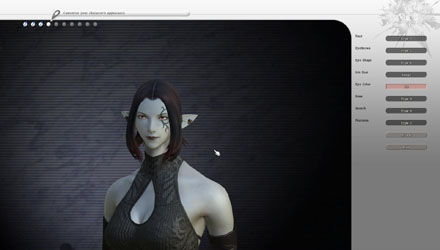
A beautiful Elzen lady in the making...
Personally, I feel that a wider use of keyboard shortcuts to access the various sub-menus would help a lot in making PC users feel “at home” with the new interface. It wouldn’t be that difficult to implement and hopefully Square-Enix will consider it during the next development cycle.
Now that we have covered the main points of contention, we can move to the rest of the game and the scenario suddenly starts to look much brighter.
The graphics are simply amazing. While the closed beta has already shown some awesome scenarios, open beta let us explore a wider area and introduced a larger amount of content. The three starting cities of Limsa Lominsa, Ul’dah and Gridania are extremely different and beautifully rendered in all their glory. The same can be said for the largely customizable characters and monsters, crowning Final Fantasy XIV as what’s doubtlessly the most beautiful looking MMORPG on the market.
Equipment, which tends to be a very important element in the general charm of a MMORPG (lots of people play for the “phat loot”, that’s a given) is simply jaw-droppingly beautiful. The extensive use of normal mapping (an effect that’s quite often absent in MMOs) shows an unprecedented amount of detail down to every little buckle, button and rivet. While Square-Enix’ designers have always been quite well-known for their ability to design extremely detailed costumes, this time around they definitely went above and beyond the call of duty, especially considering the titanic effort required by creating the many different armour pieces required by an MMORPG. Differentiation is indeed one of the strong points of the Final Fantasy XIV equipment design. Even in the same level ranges there are many different options for the same class, even beyond the simplest variation in colour schemes offered by the use of dyes.
While in many MMORPGs, especially at launch, it’s very easy to see many people dressed exactly in the same way, this problem seems to be absent in FFXIV, allowing a lovely degree of customization of one’s visual appearance, further improved by the fact that every piece of equipment is displayed on the character model, including jewellery and eyewear. Pictures, though, work better than a thousand words, so you can experience the lovely graphics of the game in this flickr gallery, which features more than three-hundred pictures from the open beta.
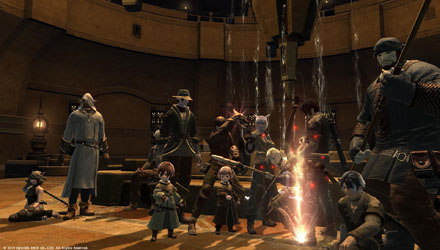
It's almost impossible to find two characters that look the same
Animation is another area where the game excels: Square-Enix used their state-of-the-art motion capture studio based on forty-four Vicon cameras and it shows. Every single character motion is extremely realistic and emotes are some of the most expressive I’ve seen in an MMORPG. Monster animation shows the same high quality, with more parts in motion on any model than your eye will be able to follow. The overall effect is very realistic and sometimes even borderline adorable (when you see the Dodos in-game you’ll understand what I mean).
Final Fantasy XIV is the first Final Fantasy game in the last ten years for which Nobuo Uematsu has composed the full score and it’s quite noticeable. I can easily go out on a limb and say that the soundtrack is the very best featured in any MMORPG on the market, past and present.
The whole score simply drools classic Final Fantasy spirit and with more than seventy different tracks it covers a range of situations and emotions. Not only do different zones have different background music but also guildleves (the game’s repeatable quests that I’ll cover below) done in different areas, feature different tracks. Final Fantasy fans might want to try the game out even just for the music, that’s pretty much for sure.
Beyond graphics and music, of course, gameplay is what makes or breaks any MMORPG and provided that the player is willing to get past the aforementioned hurdle of the UI (that hopefully will disappear in the released game, or at the very least soon), Final Fantasy XIV features some very interesting gameplay design choices.
The class system, defined “armoury” system is quite original, albeit slightly derivative from Final Fantasy XI and shows off as one of the more interesting in the current MMORPG market. Not only does it involve the ability to switch between any combat and crafting classes just by changing the equipped weapons/tools but it also allows the player to mix and match abilities from any class with their current one.
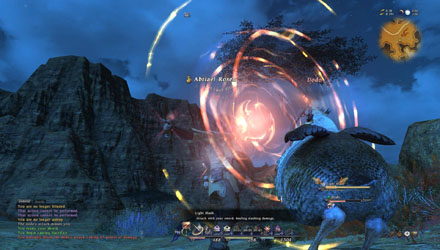
Even a Gladiator can heal thanks to the Armoury system
Every time you learn an ability you become able to equip it at any time even with a different class, allowing you to create the perfect build for your personal fighting style and chosen role. For instance a player that wants to play a tank can level Gladiator as a main class and then work on some Thaumaturge abilities for aggro control and reactive damage, or pugilist and marauder for further tanking abilities, or any combination of those classes.
While there’s a limit (that increases with each level) to the abilities that can be equipped at the same time, the system is extremely flexible and interesting to explore.
I don’t doubt that after release the usual cookie-cutter builds will start to surface but the wealth of abilities available is so wide that most probably there will still be a lot of space for personal exploration and customization. Such a wide variation in character builds, of course, influences combat quite deeply, encouraging the player to adapt their play style according to the enemy they’re fighting.
The pace isn’t overly twitchy or overly slow. Personally I find it quite spot-on as it gives the player enough time to plan ahead without becoming boring. There is no auto-attack and every ability uses up part of a stamina bar that will be constantly recharging. This encourages keeping an ideal pace over mindless button mashing and leads to the necessity of administering one’s stamina resources quite tactically to avoid spamming a burst of attacks too quickly (a tactic that can still be very practical when a monster is almost dead), only to remain exposed to the enemy while the bar recharges from zero.
The difference in efficiency between a player that has mastered the tactical use of stamina and one that just spams attacks and heals whenever he has some stamina to spare is very noticeable, requiring a certain degree of tactical thinking and skill to excel and making the system one that’s still easy to learn but hard to master.
The primary levelling method seems to be set as completing the Guildleves. In the beta you could receive eight new adventuring/gathering Guildleves every forty-eight hours, plus another eight crafting ones.
Guildleves are mini-quests where you’re given a number of monsters/enemies as a target and you need to kill them in a period of time. Quite often they have some form of twist, like the necessity to discover disguised enemies, or the very last enemy running away and trying to lead you to an ambush. You can choose the difficulty level of any Guildleve between a scale ranging between “solo” and “legion” depending on how many other players (if any) are partaking in the mission, making them perfectly scalable, for both the solo and the group-oriented player.
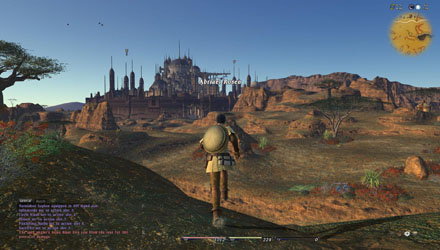
Approaching Ul'dah in all its magnificent glory...
While they lack most of the plot of traditional quests (at least at low levels), they have the undeniable advantage of never running out. The forty-eight hours cooldown was definitely too high, though and Square-Enix already announced that it will be lowered for release, ensuring that players will never easily run out, especially since they can share them with friends and strangers, effectively multiplying the number.
On top of regular Guildleves, every successful mission will award faction points, letting the player chose, once they reach a standing of one hundred with any faction, some peculiar Faction Guildleves, that feature a deeper plot, stronger enemies and better loot.
Another interesting future-proof feature of Guildleves is that new ones can be implemented rather easily, allowing Square-Enix to roll out new challenges basically with every update. The overall concept is definitely interesting and worked well in beta. In release it should work even better due to the lower cooldown and the implementation of new Guildleves.
Traditional quests are to be more focused on story lines more than on the usual “fetch this” or “kill that”. In the beta we were shown only the first two chapters of the main quest for each city, so we haven’t seen much yet. What we saw, though, was absolutely top-notch, featuring awesome cut-scenes, great characters and interesting plots.
In addition to those, Square-Enix announced that there will be further story-oriented quests available at every guild that will allow players to look further into the story of each city and to earn “guild marks”, which are a form of currency that can be used to buy peculiar class-related abilities and stats tweaks.
Personally, I love storyline quests and I’m hoping that there will be many available in the released game. While the developers said that the beta included only a vast minority of those that will be implemented at launch, their exact amount and scope remains under wraps, as do many elements of the game.
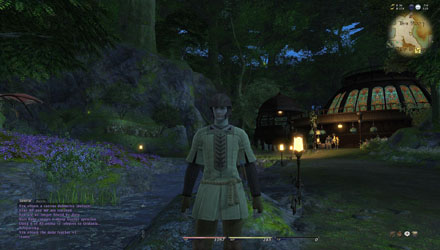
The Stained Glass of Gridania shines beautifully at night
The levelling curve seems to be set (more or less) somewhere between fast games like World of Warcraft and slow levelling games like Final Fantasy XI. Personally I found it rather easy, especially as every action you perform (whether it’s killing a monster or crafting an item) awards physical experience points. This means that anyone’s physical level will still grow whether they’re playing their favourite class or not, raising their stats and overall power in battle, making the player feel that, no matter what he’s doing, he isn’t wasting time.
This is one of my favourite features of the game, because it encourages levelling up at one’s own pace, instead of worrying too much about being left behind and what not. Whatever I am doing, I’m still progressing, so if I feel like crafting for a few hours, I will be able to do exactly that without feeling “guilty” because my friends are out there killing monsters and leaving me behind.
As I anticipated in my dedicated article a couple of weeks ago, the controversy about the Fatigue/Surplus system has proven to be much ado about nothing. In the open beta people were able to level up non-stop for tens of hours on end without even experiencing the system and being hindered by it in any sizable way. The “you can play only for X hours!” theory has been completely debunked. I guess it’s a good chance for readers to distinguish between writers and websites that hold some credibility and those that just fill pages of sensationalistic drivel in order to grab hits or satisfy some kind of agenda, isn’t it?
Crafting is decidedly one of the spotlights of the game (not surprisingly, given the number of crafting classes available). The system is based on a quite tactical mini-game that prompts players to juggle between the durability and the quality of their crafts, deciding how to proceed in order to raise the possibility to get a superior item with a lower chance of success, or to create an average item with a higher chance of getting it done.
The recipe system is very solid, with thousands of items to be created and a realistic range of ingredients that really reflect what’s being made. For instance, if you’re crafting a pair of gloves that show some evident riveting in their 3D model, you will need rivets to forge them.
The only weak point of the system is the absence of any recipe book that allows you to select all said ingredients quickly from the inventory, forcing the player to manually select them, which is rather time-consuming for the most complex recipes.
A very interesting feature, at least in my opinion, is that the economy is (besides items awarded as Guildleve rewards) almost entirely player-driven. The NPC vendors provide a wide range of basic ingredients and equipment but anything more advanced will need to be created and sold by crafters, propelling the game towards an economy system that will be made or broken by its players. It’s for sure a sandbox-oriented gamers wet dream.
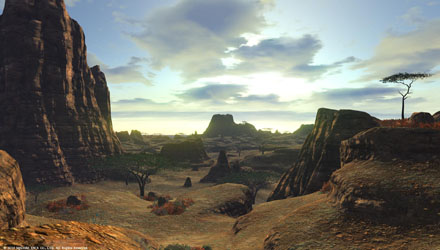
Amazing lighting and an incredible draw distance create stunning vistas
Many are complaining about the absence of an auction-house system which forces players to use their personal bazaar (or the bazaar of their personal unmanned retainer NPC), to sell their wares. We’ll have to see how that plays in the released game but, personally I have not had many problems selling what I made. In any case, the auction-house buildings are actually already in the game, just not accessible, showing that Square-Enix probably already has a “plan B” ready in case the Bazaars prove insufficient to sustain a solid economy.
Square-Enix seem to be preparing some quite interesting accessory features on top of the game itself. One is decidedly the “Lodestone”. The Lodestone is a website that seems to be an evolution of WoW’s armoury. It allows players to display their characters on the web, to write blog entries and post pictures. The system is nice and intuitive and with a bit of expansion can easily become a centerpiece of the player experience.
Unfortunately (or luckily) large areas of the game (like the central city of Ishgard, which looks really incredible seen from afar) still weren’t available in the beta, so there will be a wide unexplored part of the game at launch.
The game has definitely a lot of potential to be a keeper, or even a masterpiece, especially due to what we heard and saw at the latest pre-launch party in Tokyo, unfortunately there’s also so much that we still don’t know or haven’t seen that it’s difficult to make any surefire predictions.
What is doubtless is that the core we saw so far is solid and makes the game decidedly worth a try, keeping firm in mind that no MMORPG will ever be launched perfect.
For the rest, the release and future will tell.
Feature Type: Hands On | Tagged beta, Final Fantasy XIV, Hands-on, Impressions, MMORPG, Online, PC, Square Enix, Windows


